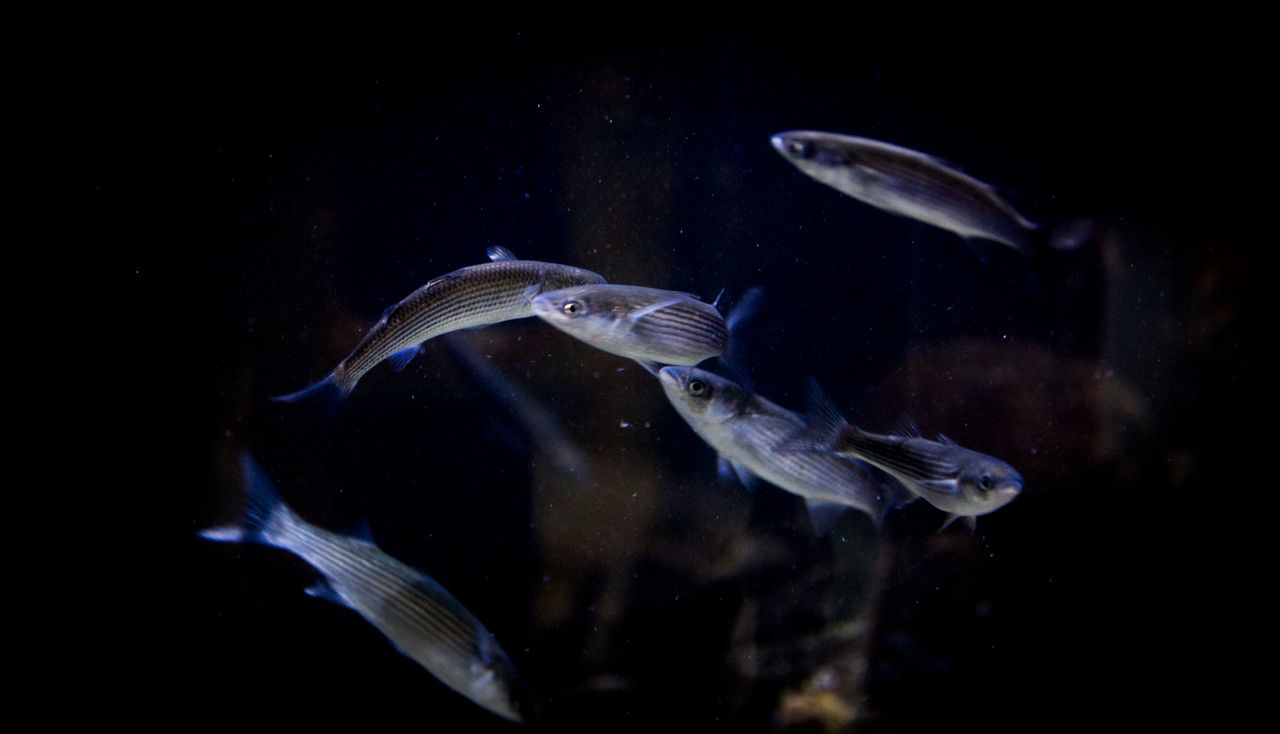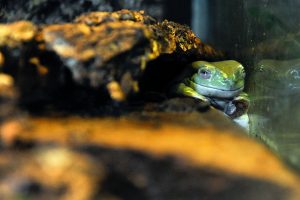
Nothing to do with the 80s haircut that’s come back into style lately, mullets are a family of fish that have been living in the ocean for thousands of years! These scaley swimmers aren’t exactly hard to find – but they are hard to catch. We prefer to keep ours off the hook, which is why you’ll find them right at home in our exhibits.
Ready to learn more about the mullet, including what it looks like, what it likes to chomp on and where in the world they live? Let’s take a look at the fishy family in more detail below.
What does a mullet fish look like?
With their long bodies and small triangular mouths, mullets are pretty distinctive-looking guys. There’s also officially three of them in the family, each with their own appearance.
Thick lipped grey mullet fish
The biggest and most common of the mullet species, the thick lipped grey can be identified by its silver scales on its back sides, which become whiter on their underside. The scales are bigger around its head and gills too. They aren’t very heavy either, usually weighing somewhere in the region of 1-2kg, although the heaviest one on record reached a weight of 6.4kg!
Thin lipped grey mullet fish
A mullet fish without the plastic surgery? Not quite! While the thin lipped grey mullet has a smaller mouth than its lippy relative, there are other things that distinguish the thin lipped mullet too. They’re lighter in colour, sometimes with a bluish tint, while the lines that run along their bodies are also much lighter. Sometimes they also have a dark spot at the base of their side (or pectoral) fin too. They’re lighter than the thick-lipped variety too, with the record heaviest mullet weighing only 3.6kg.
Golden grey mullet
The smallest of the official mullet species, the golden grey mullet is also the rarest! Appearance-wise, they’re pretty similar to the two above, although the golden mark above each gill cover does make it look rather special in our opinion. Their side fins are also the longest – if they fold them forward, they can nearly cover their eyes with them! The lightest in the family too, the golden grey’s record weight was only 1.7kg.
What does a mullet fish eat?
Mullets have a pretty strange diet, feeding mainly on organic matter from the seabed. Here, they’ll scoop seabed sediment and mud into their mouths like a spade, consuming things like plankton, algae and vegetation, and then filtering out any nasty, inedible items through their gills.
However, they’ve also been known to nibble on worms that have come loose from the seabed, as well as small pieces of dead fish, and any other animal matter that they might find on the seabed.
Mullet don’t tend to be found on the plates of many households in the UK, although some people enjoy eating them. However, any mullet swimming in polluted waters is not safe to eat at all! As you can imagine though, their small size does make them easy targets for bigger fish! It’s not just other fish that dine on them either, eagles, hawks and herons also like to make a meal of them too.
Where do mullets live?
Since they’re mostly a European species, mullets tend to be found in the waters all across the entire continent. They’re very common in the Mediterranean Sea, have a presence in the Black Sea and can also be found along the Atlantic coast of Spain, France and Portugal. Further north where it’s colder, they also live in the f-f-f-freezing Icelandic and Nordic waters of the Baltic Sea, but they’ve also been known to call the African coast of Senegal and Gambia their home too.
As for over here in the UK, mullets can be found all over the British Isles, but they tend to prefer the south and west over the north.
Wherever they are, mullets like calm, still waters – the kinds you’d find in harbours, marinas (where they love to swim between moored boats), natural coves and bays. When it’s still enough, they can sometimes be seen swimming just below the surface of the sea in small groups too! They don’t mind salty or stagnant water either, and will swim in rivers that are very far inland as well.
Why do mullet fish jump out of water?
This isn’t the beginning of a bad joke, we promise! Mullets are sometimes called the “happy” or “jumping” mullet because it looks like they’re skipping along the surface of the water. This is apparently to increase the amount of oxygen in the mullet’s body – when they’re in water that has lower levels of oxygen, you’ll see them jumping more often!
Where can you find mullets at Deep Sea World?
Want to see mullets for yourself? We thought so! We’ve got them in our Scottish Seas and Rockpools exhibit, along with a load of other fishy friends for you to explore. We’ll see you there!
Fun facts about mullets
What else is there to know about mullets? How about these little tidbits below?
- The mullet can live up to 13 years, though 5 to 7 is generally the average age
- Since they feed from the ocean floor, they’re known as “bottom feeders”
- Its teeth are very small and are arranged in several rows
- Mullets don’t have what’s known as a lateral line – the organ that detects changes in the movement of water currents
- Scientists discovered that mullets move the top portion of their bodies back and forth to communicate with their pals. How cool is that?
- Despite being prey for several other species, they aren’t afraid to defend themselves with their sharp teeth!
- Anglers and fishermen have nicknamed them the grey ghost. This is because they’re extremely hard to catch, avoiding noise and even ignoring bait that’s placed right in from of them!
Type
Fish: Commercially fished herbivore
What do they eat?
Seaweed and algae
Size
Max 60cm
Water Type
Salt Water
Where are we?
Atlantic Ocean, Mediterranean Sea and Black Sea

